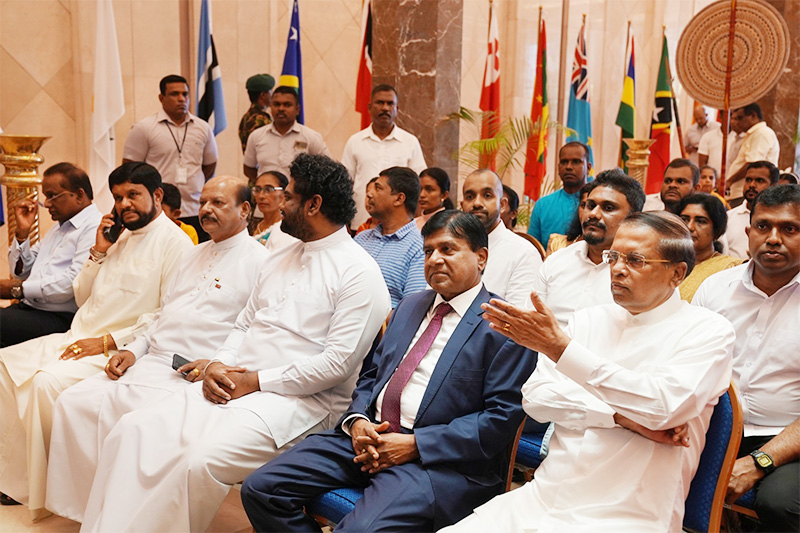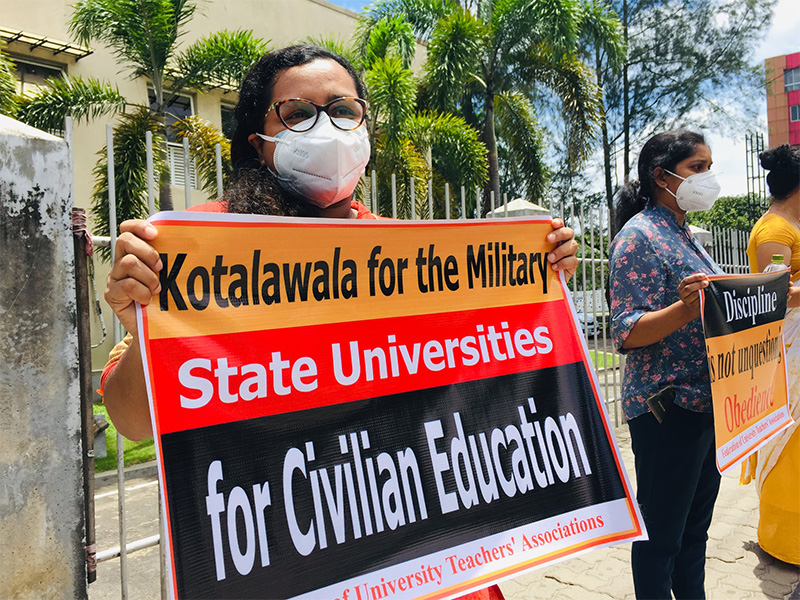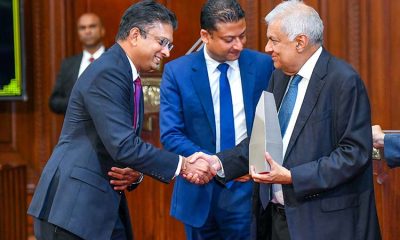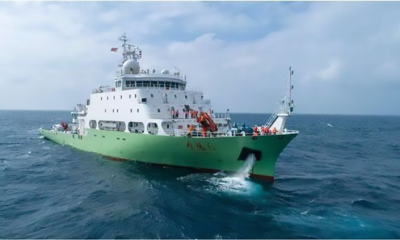Midweek Review
Stillborn in South Asia

By Lynn Ockersz
Stunted and wasted to the bone,
He is no tourist brochure pin-up boy,
As he lies huddled in his tumble-down cot,
An easy prey to disease and lingering death,
An unedited image of our development track;
And it’s not only the rural backwaters,
That those who know best have in mind,
When they unveil their bleeding stats;
It’s the country’s young as a whole,
Who are thus brought within their ken,
And we are left to make this solemn inference;
Stillborn lies South Asia’s future in its birth bed.
Midweek Review
How Yahapalana project diminished SLFP, caused current impasse

President Maithripala Sirisena dissolved Parliament in late June 2015 to save his Yahapalana partner UNP from the COPE (Committee of Public Enterprises) probe report on the first Treasury bond scam.
Having directed the then UPFA General Secretary Mahinda Amaraweera to lodge a complaint at the Commission to Investigate Allegations of Bribery or Corruption (CIABOC) soon after the media exposed the scam, President Sirisena quietly dissolved Parliament on the night of June 26, 2015, and called a General Election on August 17, 2015.
The then COPE Chief DEW Gunasekera is on record as having alleged that Sirisena dissolved Parliament to thwart him presenting the report on their findings. The Yahapalana leadership probably felt that had that happened it could have caused immense damage to the UNP campaign.
The obstruction caused by Sirisena, in late June 2015, and then declaration against the UPFA prime ministerial candidate in August 2015, exposed the SLFP leader. Sirisena plainly promoted the UNP at the expense of his own political party and those who accepted Cabinet portfolios and various other perks and privileges in terms of Sirisena’s agreement with the UNP cannot under any circumstances absolve themselves of the responsibility for the current crises. In addition, there were several SLFP State Ministers in the Yahapalana administration. The ruination of both the SLFP and the UNP was caused by Yahapalana policies and strategies. Perhaps, those interested in the issue at hand should undertake examination of facts and events leading to the destruction of two major political parties.
But can the Yahapalana lot explain to the country not just what they did with money obtained from two massive Central Bank bond scams, but what they did with USD 12.5 billion they borrowed at high interest from the international bond market and the one billion USD they got for the brand new Hambantota Harbour by renting it out to China on a 99-year lease. And how much did our comrades, who were hand in glove with that regime get for their share of theatrics?
By Shamindra Ferdinando
Maithripala Sirisena, in his capacity as the Yahapalana President and leader of the SLFP, resorted to an utterly irresponsible course of action in 2015.
Having won the 2015 presidential election, with the support of a UNP-led coalition that included the TNA and the JVP, the one-time SLFP General Secretary had no option but to fully cooperate with the UNP. President Sirisena bent over backwards to appease the members of the Coalition that ensured his victory. The TNA that once recognized the LTTE as the sole representative of the Tamil speaking people, delivered all Northern and Eastern electorates to Sirisena, on a platter.
The developing crisis in the SLFP, in the run-up to the presidential election later this year, cannot be examined without taking into consideration Sirisena’s unscrupulous actions during the Yahapalana administration before relations between the President and the UNP deteriorated, especially after the heavy setbacks the Yahapalana partners suffered at the Local Government polls in February 2018. By then, their relations had suffered irreparable damage and Sirisena was exploring ways and means of bringing Premier Ranil Wickremesinghe down to his knees.
At the time Sirisena switched his allegiance to Wickremesinghe, in late 2014, the then SLFP-led UPFA enjoyed a near 2/3 majority in Parliament, having won 144 seats, an increase of 39 seats at the April 2010 General Election since the previous parliamentary poll conducted in 2004. Today, under Sirisena’s faltering leadership, the SLFP parliamentary group consists of just 14 MPs. Of them, 12 had been elected on the SLPP ticket. with one appointed on the SLPP National List (Dr. Suren Raghavan) and only one elected on the SLFP ticket (Jaffna district lawmaker Angajan Ramanathan).
Sirisena, fighting on multiple fronts, has the backing of only one MP. Kegalle District MP Sarathi Dihsmantha Mithrapala seems to be the only lawmaker so far confident of Sirisena regaining control of the party against the backdrop of twice President Chandrika Bandaranaike Kumaratunga moving Court against the shackled SLFP leader. Sirisena’s move to bring in Justice Minister Dr. Wijeyadasa Rajapakshe, PC, too, has backfired with the contentious SLFP leadership row now beyond the hands of the various SLFP factions.
Former President Sirisena’s recent claims, regarding Indian involvement in the 2019 Easter Sunday carnage, has given a new dimension to the post-war developments here.
Having accused the Nimal Siripala-Mahinda Amaraweera led group, backed by Mrs. Kumaratunga of trying to align the SLFP with President Wickremesinghe’s UNP, Sirisena has surprised all by reaching a consensus with Justice Minister Dr. Rajapakshe on the post of Acting Chairman of the party. Sirisena had Dr. Rajapakshe elected in response to Mrs. Kumaratunga’s group naming Nimal Siripala de Silva as the Acting Chairman. Both Acting Chairmen, Nimal Siripala de Silva and Dr. Rajapakshe are members of Wickremesinghe’s Cabinet and the move on the part of SLFP factions to elect outsiders as Acting Chairmen seemed absurd.
Sajin Vass Gunawardena, who once wielded immense political clout as monitoring MP of the Foreign Affairs Ministry, during President Mahinda Rajapaksa’s second term, is now with Sirisena’s faction. The other post-war monitoring MP, the Rajapaksas appointed, was Duminda Silva, a former UNPer.
Bombshell declaration
Sirisena’s faction has repeatedly accused Mrs. Kumaratunga’s group of facilitating President Wickremesinghe’s political strategy.
Let us examine how Sirisena cooperated with the UNP, having betrayed the party in the run-up to the 2015 presidential poll. It would be pertinent to mention that Sirisena contested on the ‘Swan’ symbol of the New Democratic Front (NDF). Founded in 1995, it was originally called Democratic United National Lalith Front but renamed NDF in 2009. Since then, the then General Sarath Fonseka (2010), Maithripala Sirisena (2015) and Sajith Premadasa (2019) contested under that symbol and the possibility of incumbent President Ranil Wickremesinghe, too, choosing that party to contest forthcoming presidential poll cannot be ruled out.
A few days before the General Election, on August 17, 2015, President Sirisena’s office leaked a highly controversial letter. Therein, Sirisena, in his capacity as the SLFP leader, disclosed several issues he took up with the UPFA prime ministerial candidate Mahinda Rajapaksa.
The five-page letter emphasized whatever the outcome of the election, UPFA’s prime ministerial candidate Mahinda Rajapaksa wouldn’t be appointed Premier under any circumstances, even if that party won the General Election. There hadn’t been a similar warning issued by a President here or perhaps anywhere else that their own prime ministerial candidate wouldn’t be considered for the post. That statement was meant to discourage the UPFA block vote thereby giving a clear advantage to the UNP. That betrayal caused a debilitating setback. That was Sirisena’s intention. In other words, the SLFP leader wanted the UNP to win the election at the expense of his own party. But, Mrs. Kumaratunga and her associates wouldn’t dare take up that issue as at that time all of them cooperated with the UNP to defeat the Rajapaksas. That is the ugly truth.
Sirisena’s letter to Mahinda Rajapaksa, issued to the media on Aug 13, 2017, dealt with several issues and was written with the sole purpose of releasing it to the media, just ahead of the General Election. Inquiries made by the writer at that time, revealed that Mahinda Rajapaksa’s camp decided against releasing it to avoid any unfavourable fallout.
Having warned Mahinda Rajapaksa not to expect the premiership, Sirisena proposed that in case the party won the election, the party could pick a premier from among Nimal Siripala de Silva, John Seneviratne, Chamal Rajapaksa, Athauda Seneviratne, A.H.M. Fowzie, Susil Premjayantha and Anura Priyadarshana Yapa.
Sirisena urged Rajapaksa to publicly display his magnanimity to pave the way for the appointment of a new Premier. Sirisena claimed that he was able to help the SLFP retain the presidency by giving leadership to the growing Opposition movement against Mahinda Rajapaksa due to his (Sirisena’s) qualities and the faith the electorate had in the SLFP.
Sirisena also claimed that he averted a huge electoral rout by not calling parliamentary polls immediately after his triumph at the January 8, 2015, presidential poll. Sirisena found fault with Rajapaksa for contesting from the Kurunegala district, regardless of his (Sirisena’s) specific request not to contest as it would deprive the SLFP of the support of the Tamil speaking people, civil society and the middle class.
Interestingly, on the day Sirisena leaked his letter to Mahinda Rajapaksa, Premier Wickremesinghe addressed the media at the Sri Lanka Foundation where he explained how victory for the UNP-led National Front for Good Governance (UNFGG) could help consolidate the gains made at the presidential election. Premier Wickremesinghe reiterated his unwavering commitment to the continuation of the post-presidential polls arrangement with Sirisena.
In line with his overall strategy, immediately after the conclusion of the General Election, Sirisena unceremoniously removed 25 members of the SLFP Central Committee. At the behest of Sirisena, Colombo District UPFA candidate Prasanna Solangaarachchi secured an enjoining order from the Colombo District Court to prevent the convening of the decision-making CC. That move was meant to prevent convening of that body until the conclusion of the General Election. Subsequently, Duminda Dissanayake (now a key member of the Kumaratunga-led group) in his capacity as the Acting General Secretary of the SLFP, removed CC members as directed by Sirisena.
Regardless of Sirisena’s betrayal, the UNFGG couldn’t secure a simple majority. They obtained 106 seats, including 13 National List slots whereas the UPFA won 95 seats. The UPFA parliamentary group included 12 National List slots. In terms of the agreement between Sirisena and the UNP, the former offered the required support to form a government, thereby sharing the Cabinet portfolios. Sirisena’s despicable move divided the UPFA in Parliament.
Sirisena went a step further. The Yahapalana President and Premier offered the position of Leader of the Opposition to R. Sampanthan, the leader of the TNA, though it won only 16 seats, including two National List slots at the General Election.
Had Sirisena remained neutral, the outcome at the 2015 General Election could have been either different or extremely narrow. Sirisena also denied National List slots to those who had been supportive of Mahinda Rajapaksa and openly questioned the President’s declaration that he wouldn’t be considered for Premier, under any circumstances. Sirisena packed the UPFA National List with those who had been rejected by the people as he sought to consolidate his position, regardless of consequences.
SLFP-UNP pact
Both Sirisena and Wickremesinghe agreed that tangible measures were required to thwart any attempts by the Rajapaksas to stage a comeback. Sirisena appeared to have agreed that the Treasury bond scam, perpetrated in late February 2015, just a couple of weeks after his swearing in ceremony, shouldn’t undermine a far reaching agreement between the SLFP, the main constituent of the UPFA and the UNP. SLFP Duminda Dissanayake and UNP General Secretary Kabir Hashim (KH quit UNP in early 2020 and was elected on the SJB ticket at the last General Election) signed ten agreement on behalf of their respective parties at a ceremony held at the Presidential Secretariat on August 21, 2015. The agreement basically dealt with nine major issues and was in operation for a period of two years. Dissanayake and Hashim inked the agreement immediately after Wickremesinghe was sworn in as the Premier before Sirisena.
About eight months after the signing of the agreement, the powers that be perpetrated the second Treasury bond scam. Between the signing of the agreement (Aug 2015) and the second treasury bond scam (March 2016), the Yahapalana government betrayed the war-winning armed forces at the Geneva-based United Nations Human Rights Commission. That was unparalleled treachery and till now Sri Lanka has failed to take tangible measures to set the record straight.
The Aug 2015 agreement failed to have the desired results. In fact, the flawed Sirisena-Wickremesinghe strategy caused rapid deterioration of both political parties during the Yahapalana administration. Wickremesinghe’s efforts to retain the leadership finally led his Deputy Sajith Premadasa to split and contest the last General Election under the SJB ticket. The UNP that secured 106 seats at the August 2015 General Election was reduced to just one National List slot whereas Sajith Premadasa’s SJB obtained 54 seats, including seven National List slots. The UPFA didn’t even contest the last General Election as in its place emerged the SLPP (Pohottuwa party) that handsomely won the General Election but an explosive mixture of developments and external interventions caused its collapse, paving the way for Wickremesinghe to return to power under most unusual circumstances.
Ousted President Gotabaya Rajapaksa in ‘Conspiracy to oust me from the presidency’ ascertained that in the wake of the violent protest campaign, dubbed ‘Aragalaya,’ then Prime Minister Ranil Wickremesinghe was the only person capable of restoring the rule of law in the country.
In the chapter, titled ‘The Politics of Regime Change,’ in the recently launched memoirs that dealt with the circumstances leading to his ouster in July, 2022, Gotabaya Rajapaksa recognized the UNP leader as the ideal person to overcome, what he called, mob rule.
Developing crisis
The SLFP is in such turmoil, the belittled leadership is not in a position at least to organize a proper May Day rally today. Obviously, Sirisena may have not anticipated the Colombo District Court issuing injunctions against parachuted Acting Chairman Wijeyadasa Rajapakshe, while he continues to be Justice Minister in the present government after being elected on the SLPP ticket, and Acting General Secretary Sarathi Dushmantha.
The injunctions, effective until May 8, were issued after considering a case filed by Ministers Lasantha Alagiyawanna and Mahinda Amaraweera and MP Duminda Dissanayake.
On behalf of the plaintiffs, President’s Counsel Chandaka Jayasundara presented the facts to Court and stated that it is illegal and unconstitutional for the defendants to hold those positions.
The Court was told that Wijeyadasa Rajapakshe couldn’t hold the post of Acting Chairman as he was not a member of the SLFP and it is constitutionally illegal for a member of another party to hold a position in the SLFP.
In respect of Sirisena, courts have issued two orders preventing him from functioning as the Chairman of the party in violation of SLFP Constitution whereas Sirisena has moved Court against Minister Mahinda Amaraweera alleging that the Minister defamed him. Sirisena has demanded a staggering Rs 1 bn from one of his former associates. Responding to media queries, a cheeky Amaraweera has warned Sirisena of further disclosures. Sirisena seems to be in a bind literally facing nightmare after nightmare of his own making due to unbelievable acts of treachery he has perpetrated boomeranging on him. The beleaguered suspended SLFP leader is faced with a set of problems for which there seems to be no solution. Even if the courts, in respect of ongoing cases finally decided in his favour, the SLFP has suffered such devastating damage a full and quick recovery seems unrealistic.
The SLFP is in a true dilemma as to its future. With the Election Commission, in terms of the Constitution, empowered to make official announcements on presidential elections on or after July 17, the once formidable political party that had secured President’s Office on several occasions is not sure how to reach consensus on the presidential and parliamentary polls. Of the current parliamentary group, nearly a dozen seem to be with President Wickremesinghe, Dayasiri Jayasekera on his own and Sarathi Dushmantha Mithrapala declaring his support for Sirisena who is very much unlikely to get an opportunity to re-contest Polonnaruwa on the SLPP ticket again.
Midweek Review
University to serve common people or help increase profits?

by Susantha Hewa
For many people in society, universities and academia remain a far-off entity with a certain halo, except when undergrads come to the streets to protest and confront the police. For all they (the common people) care, universities are there for those ‘smart students’ to receive higher education and get qualified for high salaried jobs. Few would dare ask whether universities have a more people-oriented role to play that would urge people to think of them as less unapproachable places.
Hasini Lecamwasam’s (HL) article “The case for a ‘university’”, which appeared in The Island of 16 April makes a strong case for narrowing down the existing gap between the universities and the general public by examining the smugly accepted and rarely questioned social, political and economic maxims that influence the processes of knowledge production in universities. In her opening sentence, HL comments on the universities’ aloofness from the common people. She says, “Any meaningful exercise in knowledge production centrally involves investigating the systems of thought that undergird our social, political, and economic arrangements, with a view to changing them to be better for more people.” She also critiques the ways in which market interests have been affecting our universities thus making them look more and more out-of-the-way.
Employable graduates
Market interests can be out of tune with academic interests, which would otherwise have been more attuned to societal needs. To take an example, let’s look at the trendy idea of university as a place for manufacturing “employable graduates”. “Why not?” one may ask. However, this seemingly reasonable question is far too narrowly premised often on focusing on the graduate’s career prospects with little concern for his due contribution to society or promoting the wellbeing of the taxpayers who have backed his education all the way. This questions the wisdom of an economy thriving on multiplying profits with little concern for the more fundamental question of aligning individual success more with the progress of the society than with boosting company’s profits. In fact, our education system, which has for decades been in congruence with a multilayered society based on wide income gaps and producing many social discontents, has to be objectively scrutinized; the sooner the better. If the personal goals of the individual had been made to be attainable through a more people-oriented education system that would have sufficiently appreciated the mutually-rewarding link between education and socio-economic stability, today’s crisis would have been more easily managed.
A good example of how market interests can tilt the scale of weightage given to subjects in favour of the business interests of the prospective employers can be found when you look at company priorities at job interviews. Companies prefer graduates with better English communication skills, despite their lower academic performance to those who have excelled in academic work but with no English language fluency to match. Surely, we can’t blame the companies whose interest lies not in academic excellence of whom they recruit, but in their fluency in English that can jack up their business. Why should they pay for the academic excellence of the candidates, if they can’t talk glibly to sell? On the part of the undergrads, why should they burn midnight oil to excel in academic work when the country cannot absorb them? Surely, their main concern is a well-paid job, a life of luxury and social recognition and all that glitz, which is reasonable in a consumerist society. In an economic environment where the most alluring aspect of education for the undergrads is made to be their future material prosperity rather than their aspirations being productively aligned with social wellbeing, the more sublime goals of education tend to become a bad joke. Bertrand Russell in his essay “Education” (Why men fight) says, “the economic machine holds them [students] prisoners”, and that it thwarts their finer impulses. He goes on to say, “… to all in some degree, education appears as a means of acquiring superiority over others; it is infected through and through with ruthlessness and glorification of social inequality”. Although Russell said so more than a century ago, his critique of misdirected education models has equal relevance in our own times.
Academia and ivory-tower
The word “academic” can be scary for a great number of people who have been denied the opportunity of higher education for different reasons. The word associates with all highbrow companions like scholastic, pedagogical, intellectual, erudite, cerebral, cultured, theoretical and philosophical. It also has another set of companions, like, for example, impractical, unrealistic, ivory-tower, irrelevant and suppositious, which are less imperious than the previous set. They inhabit another area of meanings which, more or less, revolve around the term “ivory-tower” – “a state of privileged seclusion or separation from the facts and practicalities of the real world”, as any dictionary has it. The Cambridge dictionary has the following sentence to illustrate its meaning: “Academics sitting in ivory towers have no understanding of what is important for ordinary people”. A bit embarrassing, isn’t it? However, there is no denying the fact that the word “academic” has for ages been regarded as highbrow, privileged and, more importantly, “aloof” from the common people, who earn a living “by the sweat of their brow”, as it were.
Can this aloofness be linked with an overdose of education they have received? Perhaps, this “privileged seclusion” or the aloofness of the academics is not so much the result of any ‘exalting’ education they have received as their long-accustomed pact with the prevailing social hierarchy, which espouses segregation and disregards everything that is not one’s immediate concern. Dr. Shashi Tharoor in his book, “India: from midnight to the millennium and beyond” says, “Very few Indians have a broader sense of community than that circumscribed by ties of blood, caste affiliation, or village”. This lack of empathy with those “others” outside one’s little circles of buddies connected by family ties, race, ethnicity, religion, etc., is not possibly limited to Indians, but common to all societies whose education, culture, politics and economy accept segregation and its corrosive social effects as natural and, worse, desirable. Dr. Tharoor has a quiet laugh when he writes further down about “The Indian [who] wades through dirt and filth, past open sewers and fly-speckled waste, to an immaculate home where he proudly bathes twice a day”. However, the barb can well be a critique of any society where personal interests and societal interests are perceived to inhabit separate lands. What is worthy of scrutiny is whether education can, among other things, be engineered to promote a culture that can help converge these seemingly disparate interests, which many would, unfortunately, consider as normal.
Exemplar of social equality
When a university education is primarily thought of as a way of securing a prestigious position in society, rather than getting an opportunity for pursuing one’s academic interests, the knowledge and skills gathered thereby for working for self-fulfillment, along with promoting social well-being, the result would be to produce an educated class, preoccupied with securing a slot in the profit-making machine. Rather than urging them to think of common wellbeing, it would estrange them from society and encourage them to revel in their ‘superiority’. Among the undergrads, this can be seen in its most brazen form in ragging where the seniors treat the new entrants like dirt (let’s not talk about torture), insisting them to be respected by the latter as “Their Highnesses” (Jyeshta Uttamayas). What is manifest in this is their subconscious acceptance and fusion with a culture of social stratification which rationalizes the coercive power of the “superiors”. One would have expected higher education to broaden the empathies of the scholars, but the charms of “superiority” seem to hold sway. It is open to discussion and debate whether or to what extent the “academic” pecking order reflects the convoluted hierarchies of the wider world.
Hence, the aptness of the concluding line of HL’s article in which she refuses to go with the crowd but, “continue to push agendas of critical research (likely without funding) and critical discussion in classrooms and outside (at the risk of penalisation) within universities”, so that it will ensure a wider and stronger social relevance of the universities.
Midweek Review
What a Frail Tree Tells

By Lynn Ockersz
The sapling of great promise,
Planted seven decades ago,
On a green growth model,
Hoping for the land’s denizens,
It’d be a protective canopy,
Alas, is wilting already in heat,
And giving up its precious sap,
To grasping, gangrenous hands,
So much so, instead of an Oak,
We are left with a withered palm.
-

 Business5 days ago
Business5 days agoSri Lanka Resorts of Cinnamon Hotels & Resorts mark Earth Day with impactful eco-initiatives
-

 Business6 days ago
Business6 days agoDialog Axiata recognised as the Most Significant FDI Contributor by BOI
-

 Business6 days ago
Business6 days agoUNESCAP Technical Cooperation Highlights Report flags significant strides in its partnership with Sri Lanka
-

 Business7 days ago
Business7 days agoComBank crowned ‘Best Bank in Sri Lanka’ by Global Finance for 22nd year
-

 Business7 days ago
Business7 days agoCinnamon Lakeside Colombo welcomes Nazoomi Azhar as its new General Manager
-

 News4 days ago
News4 days agoGerman research ship allowed Sri Lanka port call after Chinese-protest led clarification
-

 News4 days ago
News4 days agoSri Lankan Oil and Gas exploration grinds to a standstill amid protracted legal battle
-

 Editorial6 days ago
Editorial6 days agoShocks from Bills



























